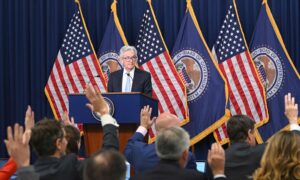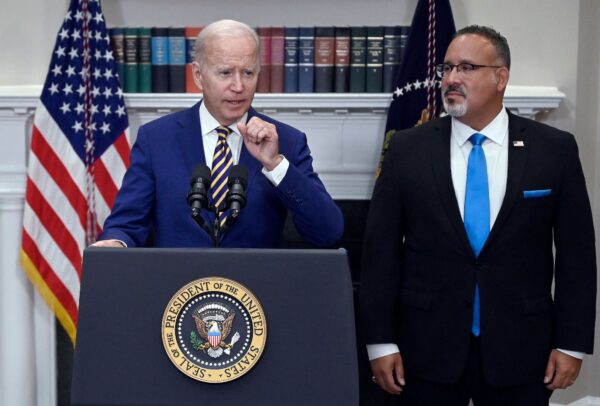Biden Admin and Fed Market Distortion
CommentaryFederal Reserve control over interest rates, combined with government money creation, distorts markets, causing booms and busts, high household debt, government deficits, and high real estate and education prices. President Joe Biden’s student loan forgiveness program will increase educational costs while increasing government spending by as much as $1.6 trillion. The market for nearly every product, from hamburgers to shoes, is governed by supply and demand. If producers charge too much for a product, demand goes down, and the price goes with it. This signals to the producers that this good is less popular, and they will produce fewer of them. If the price continues to drop, the suppliers stop producing it because there is no demand. By the same token, if demand keeps rising, the price goes up, and producers make more of that good. This happens naturally without government intervention because of supply and demand—Adam Smith’s “invisible hand.” When Bart Simpson toys were popular, Mattel’s president did not have to tell the toymaker to make more of them. There are only two areas in our economy where the government controls prices and distorts markets: minimum wage and interest rates. If the government allowed interest rates to be dictated by supply and demand, much of the boom-and-bust cycle would disappear. And when the economy becomes “overheated,” the rate would naturally adjust to bring the economy back to equilibrium. When times are slow, interest rates would come down, encouraging borrowing and promoting growth. The price of every other commodity in our economy, except oil, is dictated by supply and demand, and prices adjust on their own. This suggests that there is no need for the Fed to artificially adjust interest rates. Unnaturally low-interest rates created by the Fed encourage borrowing. The average American has $5,221 in credit card debt, while the average person borrows $39,721 to buy a new car or $27,291 to buy a used car. Considering all forms of debt—including mortgages, home equity lines of credit, and student loans—the average household debt is $96,371. If interest rates were left to market forces, much of this borrowing would never have happened. But because the Fed has kept interest rates artificially low for more than a decade, loans have been easy to get, people have spent more than they could afford, and prices have risen. President Joe Biden announces student loan relief with Education Secretary Miguel Cardona on Aug. 24, 2022 (Oliver Douliery/AFP via Getty Images) Along with the Fed controlling interest rates, the government also controls how much money it spends and borrows. Expansionary monetary and fiscal policy, and the creation of money out of thin air, are the primary causes of the business cycles of boom and bust. During Biden’s first year in office, he kept interest rates low and spent freely. In 2021, the administration spent $6.8 trillion and ran up a deficit of $2.8 trillion. So far, in 2022, it has spent $6.27 trillion, which has driven the national debt to over $31 trillion. This year, Biden claims that he will decrease the deficit, but this is only because he will stop some of the pandemic spending programs. In October, Biden extended the pandemic emergency, which means he will continue this additional spending until Jan. 11, 2023. At that point, he will be free to extend it by another 90 days if he wishes. And even if he stopped all government spending today, this would not reduce the national debt. During periods of expansionary policy, interest rates decline and malinvestment increases. Eventually, the over-inflated balloon has to pop, and citizens are left holding the bag. This is what happened during the 1920s culminating in the Great Depression. It happened again leading up to the 2008 financial crisis. And in both instances, it seems policymakers learned nothing. They cut interest rates to recover from the 2008 global financial crisis and did not raise them again until a few months ago. Now we are facing near-record inflation that does not seem to create jobs or improve the nation’s economic situation. Money creation, money printing, government debt, and government deficit spending all cause inflation. This drives up prices and hurts savers. Many politicians believe that inflation is neutral, raises prices, and as wages also rise, this generates growth and creates jobs. The truth is that inflation hurts families. While inflation would eventually raise wages to meet the higher prices, the increases would not be uniform or simultaneous across the economy. So while some people would benefit from inflation, most would be worse off—particularly anyone saving for retirement would see the value of their savings dwindle. Housing and education are two sectors of the economy with extremely high inflation. By no coincidence, these sectors are also highly correlated with interest rates because they represent the largest loans most people will ever take

Commentary
Federal Reserve control over interest rates, combined with government money creation, distorts markets, causing booms and busts, high household debt, government deficits, and high real estate and education prices. President Joe Biden’s student loan forgiveness program will increase educational costs while increasing government spending by as much as $1.6 trillion.
The market for nearly every product, from hamburgers to shoes, is governed by supply and demand. If producers charge too much for a product, demand goes down, and the price goes with it. This signals to the producers that this good is less popular, and they will produce fewer of them. If the price continues to drop, the suppliers stop producing it because there is no demand. By the same token, if demand keeps rising, the price goes up, and producers make more of that good. This happens naturally without government intervention because of supply and demand—Adam Smith’s “invisible hand.” When Bart Simpson toys were popular, Mattel’s president did not have to tell the toymaker to make more of them.
There are only two areas in our economy where the government controls prices and distorts markets: minimum wage and interest rates. If the government allowed interest rates to be dictated by supply and demand, much of the boom-and-bust cycle would disappear. And when the economy becomes “overheated,” the rate would naturally adjust to bring the economy back to equilibrium. When times are slow, interest rates would come down, encouraging borrowing and promoting growth. The price of every other commodity in our economy, except oil, is dictated by supply and demand, and prices adjust on their own. This suggests that there is no need for the Fed to artificially adjust interest rates.
Unnaturally low-interest rates created by the Fed encourage borrowing. The average American has $5,221 in credit card debt, while the average person borrows $39,721 to buy a new car or $27,291 to buy a used car. Considering all forms of debt—including mortgages, home equity lines of credit, and student loans—the average household debt is $96,371. If interest rates were left to market forces, much of this borrowing would never have happened. But because the Fed has kept interest rates artificially low for more than a decade, loans have been easy to get, people have spent more than they could afford, and prices have risen.

Along with the Fed controlling interest rates, the government also controls how much money it spends and borrows. Expansionary monetary and fiscal policy, and the creation of money out of thin air, are the primary causes of the business cycles of boom and bust.
During Biden’s first year in office, he kept interest rates low and spent freely. In 2021, the administration spent $6.8 trillion and ran up a deficit of $2.8 trillion. So far, in 2022, it has spent $6.27 trillion, which has driven the national debt to over $31 trillion. This year, Biden claims that he will decrease the deficit, but this is only because he will stop some of the pandemic spending programs. In October, Biden extended the pandemic emergency, which means he will continue this additional spending until Jan. 11, 2023. At that point, he will be free to extend it by another 90 days if he wishes. And even if he stopped all government spending today, this would not reduce the national debt.
During periods of expansionary policy, interest rates decline and malinvestment increases. Eventually, the over-inflated balloon has to pop, and citizens are left holding the bag. This is what happened during the 1920s culminating in the Great Depression. It happened again leading up to the 2008 financial crisis. And in both instances, it seems policymakers learned nothing. They cut interest rates to recover from the 2008 global financial crisis and did not raise them again until a few months ago. Now we are facing near-record inflation that does not seem to create jobs or improve the nation’s economic situation.
Money creation, money printing, government debt, and government deficit spending all cause inflation. This drives up prices and hurts savers. Many politicians believe that inflation is neutral, raises prices, and as wages also rise, this generates growth and creates jobs. The truth is that inflation hurts families. While inflation would eventually raise wages to meet the higher prices, the increases would not be uniform or simultaneous across the economy. So while some people would benefit from inflation, most would be worse off—particularly anyone saving for retirement would see the value of their savings dwindle.
Housing and education are two sectors of the economy with extremely high inflation. By no coincidence, these sectors are also highly correlated with interest rates because they represent the largest loans most people will ever take. Thus, the Fed’s manipulation of interest rates also affects the price of housing and education.
Since 1970, housing prices have increased by a cumulative rate 150 percent higher than inflation. In the past year alone, housing increased by over 18 percent. The artificially low-interest rates controlled by the Fed have caused both education and housing to reach unnaturally high prices. When the Fed suppresses interest rates, borrowing becomes cheaper and housing prices go up. Generous student loan programs similarly encouraged borrowing and drove up education prices. If Biden moves forward with his loan forgiveness program, the cost of education will skyrocket.
At the same time, the Fed is now artificially raising interest rates to fight inflation, but economists warn that higher rates may cause a recession.
Views expressed in this article are the opinions of the author and do not necessarily reflect the views of The Epoch Times.












